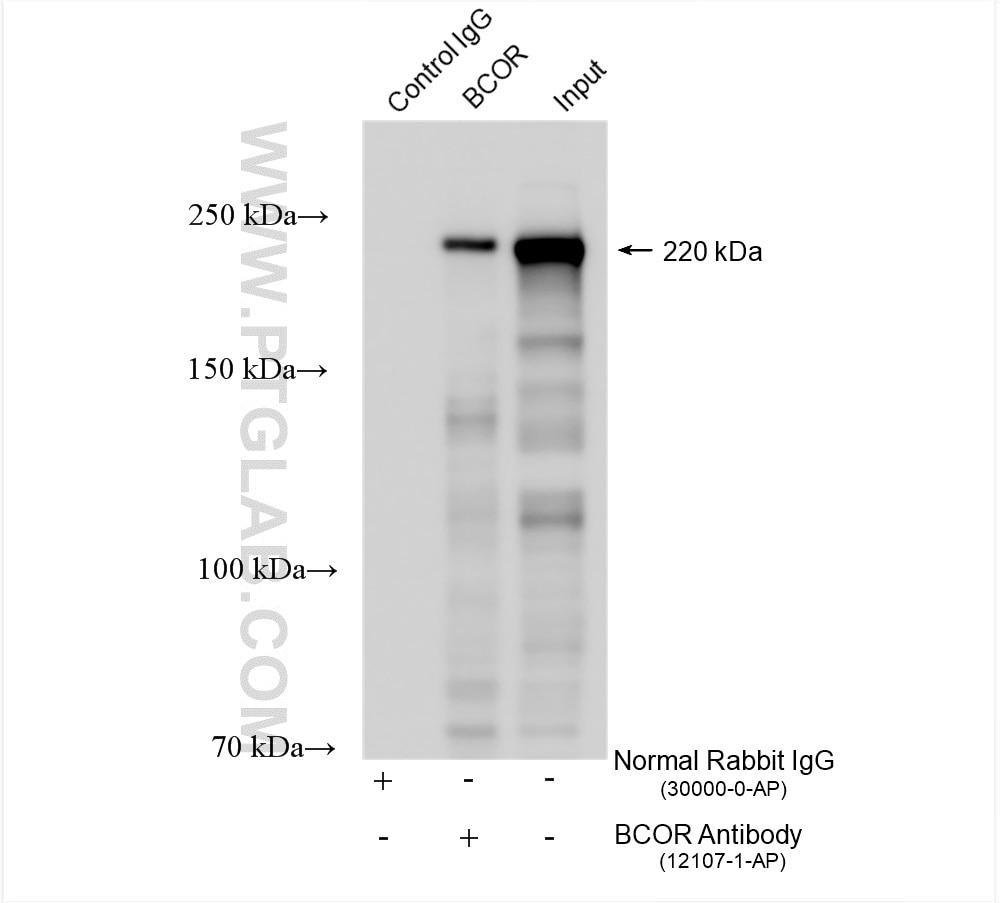BCOR Polyklonaler Antikörper
BCOR Polyklonal Antikörper für WB, IP, IHC, ELISA
Wirt / Isotyp
Kaninchen / IgG
Getestete Reaktivität
human, Maus, Ratte
Anwendung
WB, IP, IHC, CoIP, ChIP, ELISA
Konjugation
Unkonjugiert
Kat-Nr. : 12107-1-AP
Synonyme
Galerie der Validierungsdaten
Geprüfte Anwendungen
| Erfolgreiche Detektion in WB | HEK-293-Zellen, HeLa-Zellen, K-562-Zellen |
| Erfolgreiche IP | HEK-293-Zellen |
| Erfolgreiche Detektion in IHC | humanes Mammakarzinomgewebe Hinweis: Antigendemaskierung mit TE-Puffer pH 9,0 empfohlen. (*) Wahlweise kann die Antigendemaskierung auch mit Citratpuffer pH 6,0 erfolgen. |
Empfohlene Verdünnung
| Anwendung | Verdünnung |
|---|---|
| Western Blot (WB) | WB : 1:2000-1:10000 |
| Immunpräzipitation (IP) | IP : 0.5-4.0 ug for 1.0-3.0 mg of total protein lysate |
| Immunhistochemie (IHC) | IHC : 1:50-1:500 |
| It is recommended that this reagent should be titrated in each testing system to obtain optimal results. | |
| Sample-dependent, check data in validation data gallery | |
Veröffentlichte Anwendungen
| WB | See 6 publications below |
| IHC | See 3 publications below |
| CoIP | See 1 publications below |
| ChIP | See 2 publications below |
Produktinformation
12107-1-AP bindet in WB, IP, IHC, CoIP, ChIP, ELISA BCOR und zeigt Reaktivität mit human, Maus, Ratten
| Getestete Reaktivität | human, Maus, Ratte |
| In Publikationen genannte Reaktivität | human, Maus |
| Wirt / Isotyp | Kaninchen / IgG |
| Klonalität | Polyklonal |
| Typ | Antikörper |
| Immunogen | BCOR fusion protein Ag2752 |
| Vollständiger Name | BCL6 co-repressor |
| Berechnetes Molekulargewicht | 1703 aa, 186 kDa |
| Beobachtetes Molekulargewicht | 186 kDa |
| GenBank-Zugangsnummer | BC009675 |
| Gene symbol | BCOR |
| Gene ID (NCBI) | 54880 |
| Konjugation | Unkonjugiert |
| Form | Liquid |
| Reinigungsmethode | Antigen-Affinitätsreinigung |
| Lagerungspuffer | PBS mit 0.02% Natriumazid und 50% Glycerin pH 7.3. |
| Lagerungsbedingungen | Bei -20°C lagern. Nach dem Versand ein Jahr lang stabil Aliquotieren ist bei -20oC Lagerung nicht notwendig. 20ul Größen enthalten 0,1% BSA. |
Hintergrundinformationen
BCOR, a corepressor of BCL6, binds to transcriptional factors and specifically inhibits gene expression. BCOR plays a key role in the early embryonic development, mesenchymal stem cell function and hematopiesis. BCOR can associate with HDACs, the polycomb group protein, polycomb group Ring finger protein1/nervous system polycomb1 (PCGF1/NSPC1), histone demethylase, F-box- and leucine-rich repeat protein10(FBXL10). Via repression of TFAP2A acts as a negative regulator of osteo-dentiogenic capacity in adult stem
Protokolle
| Produktspezifische Protokolle | |
|---|---|
| WB protocol for BCOR antibody 12107-1-AP | Protokoll herunterladen |
| IHC protocol for BCOR antibody 12107-1-AP | Protokoll herunterladen |
| IP protocol for BCOR antibody 12107-1-AP | Protokoll herunterladen |
| Standard-Protokolle | |
|---|---|
| Klicken Sie hier, um unsere Standardprotokolle anzuzeigen |
Publikationen
| Species | Application | Title |
|---|---|---|
Nat Genet Consistent in-frame internal tandem duplications of BCOR characterize clear cell sarcoma of the kidney. | ||
Nucleic Acids Res Bimodal regulation of the PRC2 complex by USP7 underlies tumorigenesis. | ||
Int J Mol Sci BCOR Internal Tandem Duplication Expression in Neural Stem Cells Promotes Growth, Invasion, and Expression of PRC2 Targets. | ||
Sci Rep Loss of Polycomb Group Protein Pcgf1 Severely Compromises Proper Differentiation of Embryonic Stem Cells. | ||
Cell Prolif Secreted frizzled-related protein 2 promotes the osteo/odontogenic differentiation and paracrine potentials of stem cells from apical papilla under inflammation and hypoxia conditions. | ||
J Clin Pathol Novel exon-exon breakpoint in CIC-DUX4 fusion sarcoma identified by anchored multiplex PCR (Archer FusionPlex Sarcoma Panel). |
Rezensionen
The reviews below have been submitted by verified Proteintech customers who received an incentive for providing their feedback.
FH Sid (Verified Customer) (05-13-2019) | Works well for mouse hematopoetic cells, some strong non specific bands ~ 150 kD and ~100 kD, however can be reasonably resolved on 4-15% gel.
|






